The Influence of Increased Salvage Felling on Forwarding Distance and the Removal—A Case Study from Croatia
Abstract
1. Introduction
2. Materials and Methods
2.1. Study Area
2.2. Data
- Road density,
- Average theoretical forwarding distance (Equation (1)):where are:
- gc—road density, m/ha
- st—theoretical forwarding distance, m
- e—distance between roads, m
- L—road length, m
- Average geometrical forwarding distance (Euclidean distance tool in ArcGIS 10.3),
- Road network factor (Equation (2)):
- fpol—cutblock position factor
- —average realised geometrical forwarding distance, m
- st—theoretical forwarding distance, m
- sgi—shortest distance from the regular point network to primary forest infrastructure, m
- n—number of points in the regular network within the sub-compartments with felling operations
- frem—removal position factor
- —weighted realised geometrical forwarding distance, m
- st—theoretical forwarding distance, m
- —weighted arithmetic mean of the average geometric forwarding distances of individual—sub-compartments, m
- Vi—felled timber volume in specific sub-compartment, m3
- n—number of sub-compartments with felling operations
3. Results
3.1. Analysis of Timber Volume
3.2. Analysis of the Forest Accessibility
3.3. Analysis of the Average Forwarding Distances in Space and Time and Relative Forest Openness
4. Discussion
5. Conclusions
Author Contributions
Funding
Data Availability Statement
Conflicts of Interest
References
- Dodson, E.M. 2021: Challenges in Forest Road Maintenance in North America. Croat. J. For. Eng. 2021, 42. In press. [Google Scholar]
- Stampfer, K.; Pentek, T.; Đuka, A. Timber Harvesting in Europe—Trends. In Proceedings of the Current Position and Perspectives of Forestry and Wood Technology in the 21st Century, Zagreb, Croatia, 18–19 October 2018; p. 1. [Google Scholar]
- Papa, I.; Pentek, T.; Lepoglavec, K.; Nevečerel, H.; Poršinsky, T.; Tomašić, Ž. Methodology of Development of Detailed Primary Forest Traffic Infrastructure Register as the Basis for Forest road Maintenance Planning and Optimization. Šumarski List 2015, 139, 311–328. [Google Scholar]
- Laschi, A.; Foderi, C.; Fabiano, F.; Neri, F.; Cambi, M.; Mariotti, B.; Marchi, E. Forest road planning, construction and maintenance to improve forest fire fighting: A review. Croat. J. For. Eng. 2019, 40, 207–219. [Google Scholar]
- Epstein, R.; Weintraub, A.; Sapunar, P.; Nieto, E.; Sessions, J.B.; Sessions, J.; Bustamante, F.; Musante, H. A combinatorial heuristic approach for solving real-size machinery location and road design problems in forestry planning. Oper. Res. 2006, 54, 1017–1027. [Google Scholar] [CrossRef]
- Dietz, P.; Knigge, W.; Löffler, H. Walderschließung; Verlag Paul Parey: Hamburg/Berlin, Germany, 1984; pp. 1–426. [Google Scholar]
- Landekić, M.; Martinić, I.; Bakarić, M.; Pentek, T.; Poršinsky, T.; Šporčić, M. Current State and Improvement Potential of Forestry Workers Training in Croatia. Croat. J. For. Eng. 2018, 39, 51–60. [Google Scholar]
- Paluš, H.; Parobek, J. Changing patterns of roundwood deliveries in Slovakia. Markets for Wood and Wooden Products. In Markets for Wood and Wooden Products; Jelačić, D., Ed.; WoodEMA: Vinkovci, Croatia, 2013; pp. 77–91. [Google Scholar]
- Paladinić, E.; Štimac, D.; Marjanović, H.; Balenović, I.; Ostrogović, M.Z. Production Aspect of Silver Fir (Abies alba Mill.) Dieback on Example of a Few Beech-Fir Stands. Šumarski List 2011, 135, 248–263. [Google Scholar]
- EEA. Climate change, impacts and vulnerability in Europe 2012—An indicator-based report. In EEA Report No 12/2012; European Environment Agency: Copenhagen, Denmark, 2012; pp. 1–300. [Google Scholar]
- Prka, M.; Krpan, A.P. The Problem of Establishing the Assortment Structure of Even-Aged Beech Stands. Šumarski List 2007, 131, 219–235. [Google Scholar]
- Bumber, Z. Application of GIS in Analyzing Forest Openness of MU Šiljakovačka dubrava II through Removal Structure over Space and Time. Master’s Thesis, Forestry Faculty of Zagreb University, Zagreb, Croatia, 2011. [Google Scholar]
- Mederski, P.S.; Borz, S.A.; Đuka, A.; Lazdiņš, A. Challenges in Forestry and Forest Engineering—Case Studies from Four Countries in East Europe. Croat. J. For. Eng. 2021, 42. In Press. [Google Scholar]
- Čavlović, J.; Teslak, K.; Beljan, K. The Effects of Different Stand Regeneration Planning on Management and Pedunculate Oak Forest Development—A Small Size Management Class Case Study. Šumarski List 2014, 138, 123–134. [Google Scholar]
- Pentek, T. The Computer Models for Forest Roads Network Optimization with Regard to the Dominant Influential Factors. Ph.D. Thesis, Forestry Faculty of Zagreb University, Zagreb, Croatia, 2002. [Google Scholar]
- Bylaw on Measure Implementation M04 “Investments in Physical Assets”, By-Measure 4.3 “Grant for Investments in Development, Modernization and Customization of Agriculture and Forestry”, Operation Type 4.3.3 “Investments in Forest Infrastructure” from the Program of Rural Development in Republic of Croatia in Period from 2014 to 2020 (OG 106/15, 65/17, 77/17). Available online: https://narodne-novine.nn.hr/ (accessed on 15 November 2020).
- Ciancio, O.; Corona, P.; Iovino, F.; Menguzzato, G.; Scotti, R. Forest Management on a Natural Basis. J. Sustain. For. 1999, 9, 59–72. [Google Scholar] [CrossRef]
- Suzuki, Y.; Yoshimura, T. Assessment of Broad-Leaved Forest Stand Management: Stock Densities, Thinning Costs and Profits over a 60-Year Rotation Period. Croat. J. For. Eng. 2019, 40, 365–375. [Google Scholar] [CrossRef]
- Bruhn, J.N.; Wetteroff, J.J.; Mihail, J.D.; Kabrick, J.M.; Pickens, J.B. Distribution of Armillaria species in upland Ozark Mountain forests with respect to site, overstory species composition and oak decline. For. Pathol. 2000, 30, 43–60. [Google Scholar] [CrossRef]
- Picchio, R.; Tavankar, F.; Venanzi, R.; Monaco, A.L.; Nikooy, M. Study of Forest Road Effect on Tree Community and Stand Structure in Three Italian and Iranian Temperate Forests. Croat. J. For. Eng. 2018, 39, 57–70. [Google Scholar]
- Pellegrini, M.; Grigolato, S.; Cavalli, R. Spatial MultiCriteria Decision Process to Define Maintenance Priorities of Forest Road Network: An Application in the Italian Alpine Region. Croat. J. For. Eng. 2013, 34, 31–42. [Google Scholar]
- Grigolato, S.; Pellegrini, M.; Cavalli, R. Temporal analysis of the traffic loads on forest road networks. iForest Biogeosci. For. 2013, 6, 255–261. [Google Scholar] [CrossRef]
- Duka, A.; Grigolato, S.; Papa, I.; Pentek, T.; Poršinsky, T. Assessment of timber extraction distance and skid road network in steep karst terrain. iForest Biogeosci. For. 2017, 10, 886. [Google Scholar] [CrossRef]
- Hayati, E.; Majnounian, B.; Abdi, E. Qualitative evaluation and optimization of forest road network to minimize total costs and environmental impacts. iForest Biogeosci. For. 2017, 5, 121–125. [Google Scholar] [CrossRef]
- Picchio, R.; Pignatti, G.; Marchi, E.; Latterini, F.; Benanchi, M.; Foderi, C.; Venanzi, R.; Verani, S. The application of two approaches using GIS technology implementation in forest road network planning in an Italian mountain setting. Forests 2018, 9, 277. [Google Scholar] [CrossRef]
- Picchio, R.; Latterini, F.; Mederski, P.S.; Tocci, D.; Venanzi, R.; Stefanoni, W.; Pari, L. Applications of GIS-Based Software to Improve the Sustainability of a Forwarding Operation in Central Italy. Sustainability 2020, 12, 5716. [Google Scholar] [CrossRef]
- Mikac, S.; Žmegač, A.; Trlin, D.; Paulić, V.; Oršanić, M.; Anić, I. Drought-induced shift in tree response to climate in floodplain forests of Southeastern Europe. Sci. Rep. 2018, 8, 16495. [Google Scholar] [CrossRef]
- Skiadaresis, G.; Schwarz, J.A.; Bauhus, J. Groundwater Extraction in Floodplain Forests Reduces Radial Growth and Increases Summer Drought Sensitivity of Pedunculate Oak Trees (Quercus robur L.). Front. For. Glob. Chang. 2019, 2, 5. [Google Scholar] [CrossRef]
- Đuka, A.; Poršinsky, T.; Pentek, T.; Pandur, Z.; Vusić, D.; Papa, I. Mobility Range of a Cable Skidder for Timber Extraction on Sloped Terrain. Forests 2018, 9, 526. [Google Scholar] [CrossRef]
- Marchi, E.; Chung, W.; Visser, R.; Abbas, D.; Nordfjell, T.; Mederski, P.S.; McEwan, A.; Brink, M.; Laschi, A. Sustainable Forest Operations (SFO): A new paradigm in a changing world and climate. Sci. Total Environ. 2018, 634, 1385–1397. [Google Scholar] [CrossRef] [PubMed]
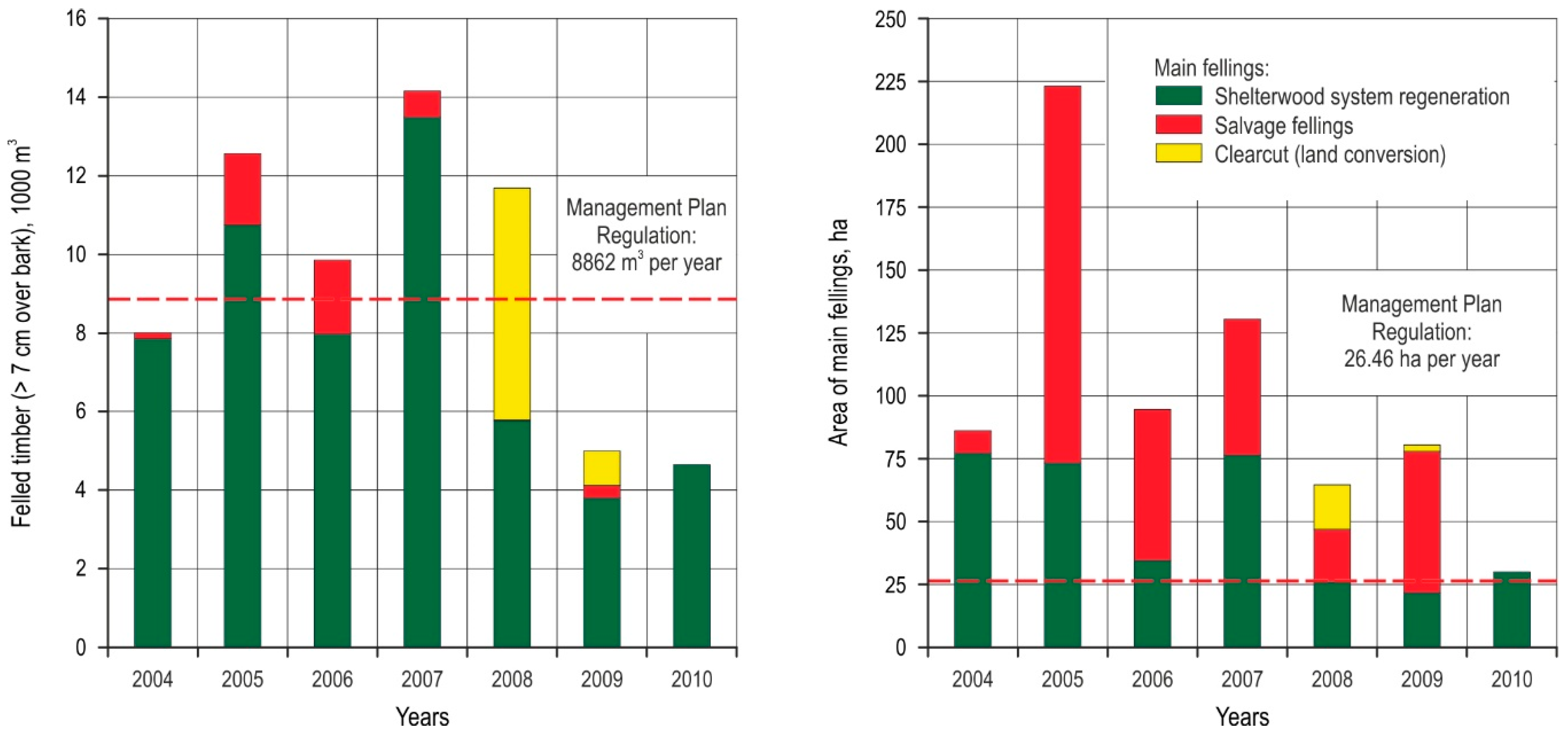
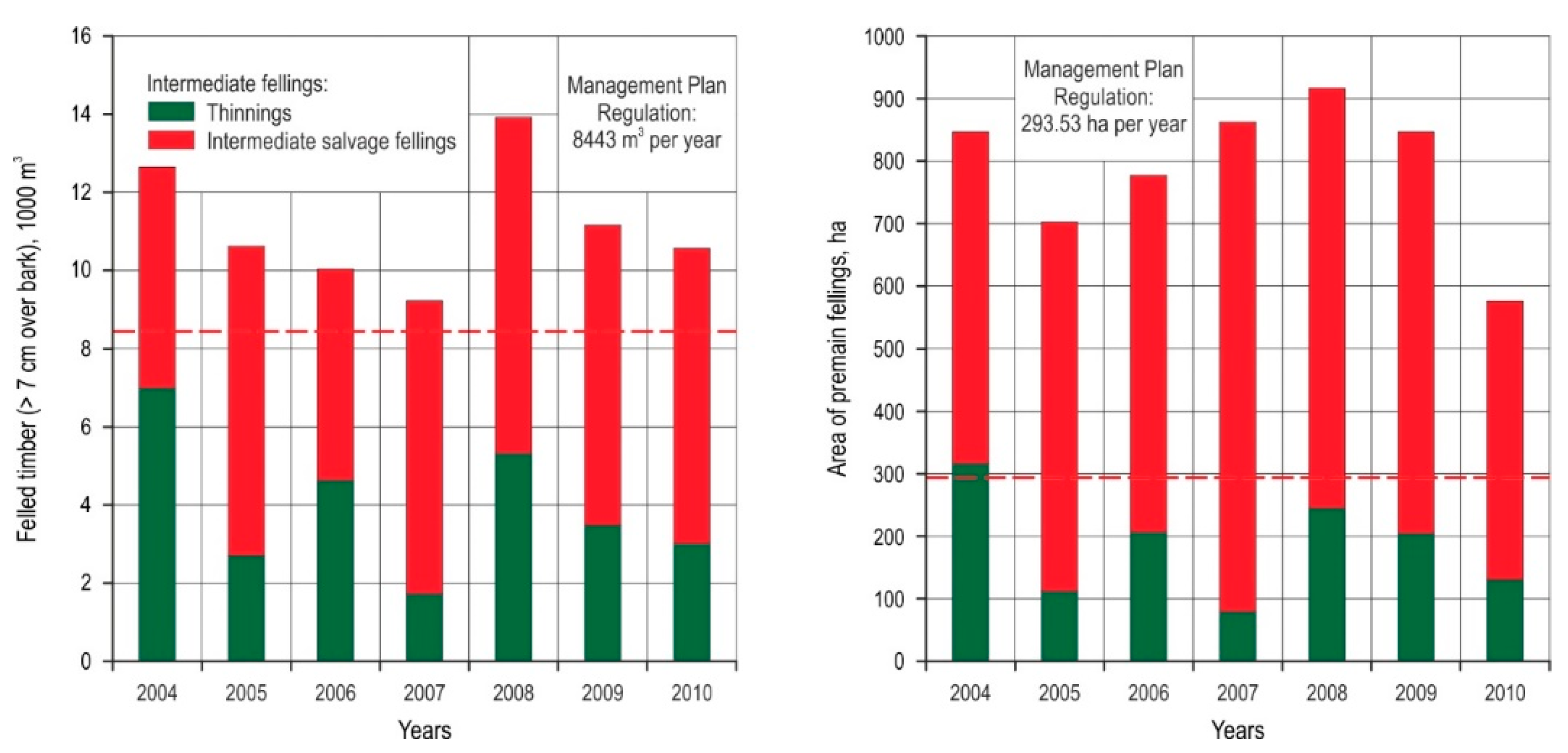

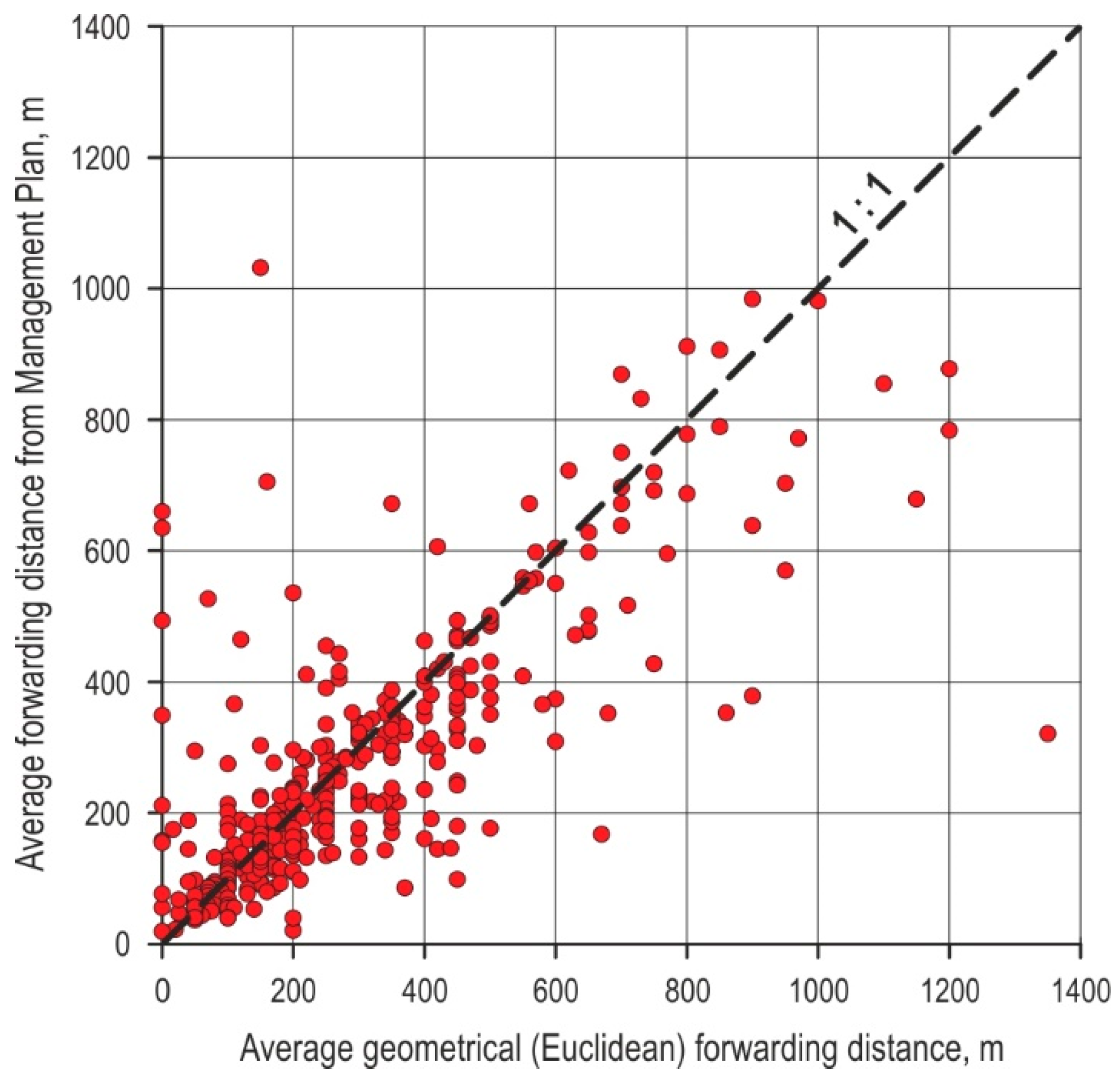
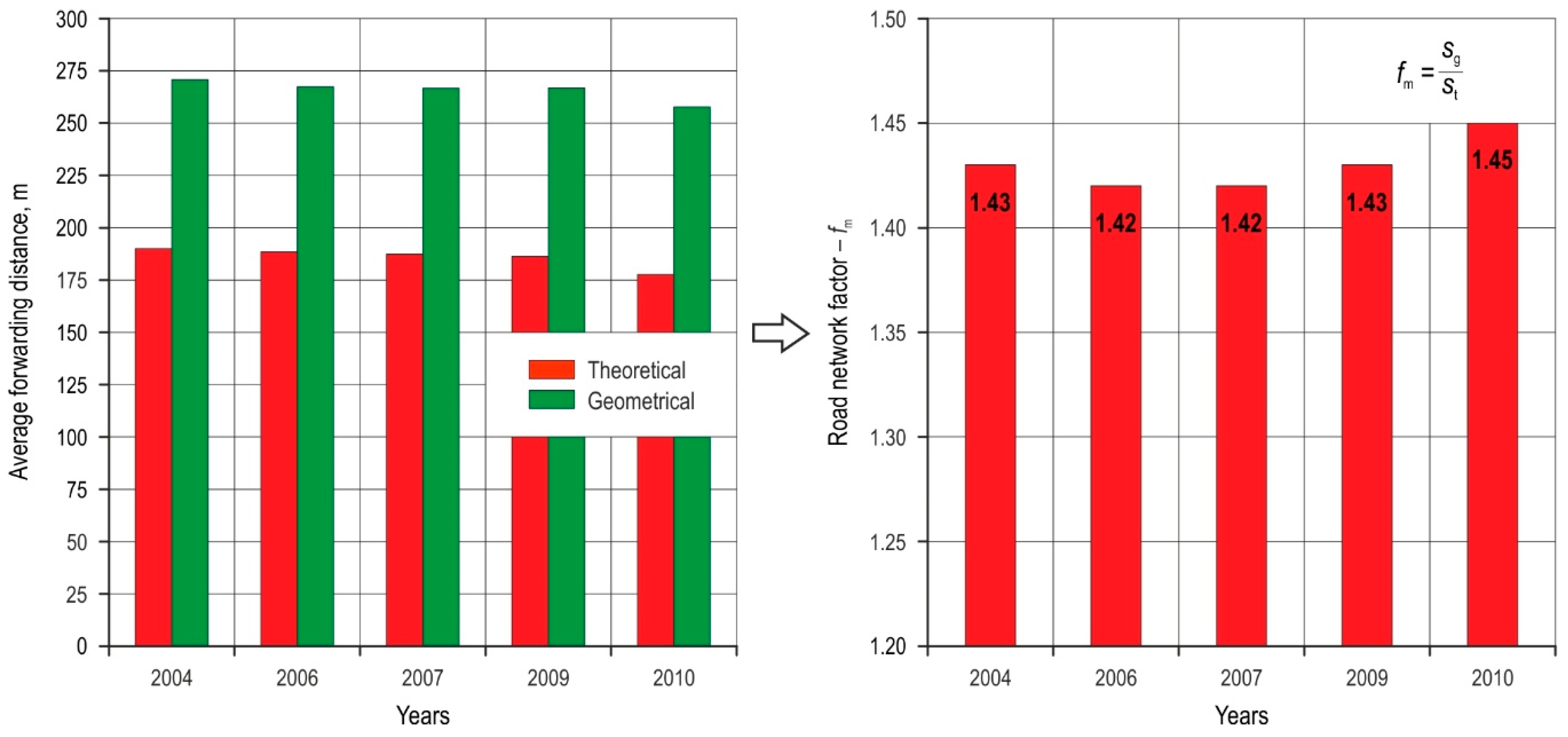
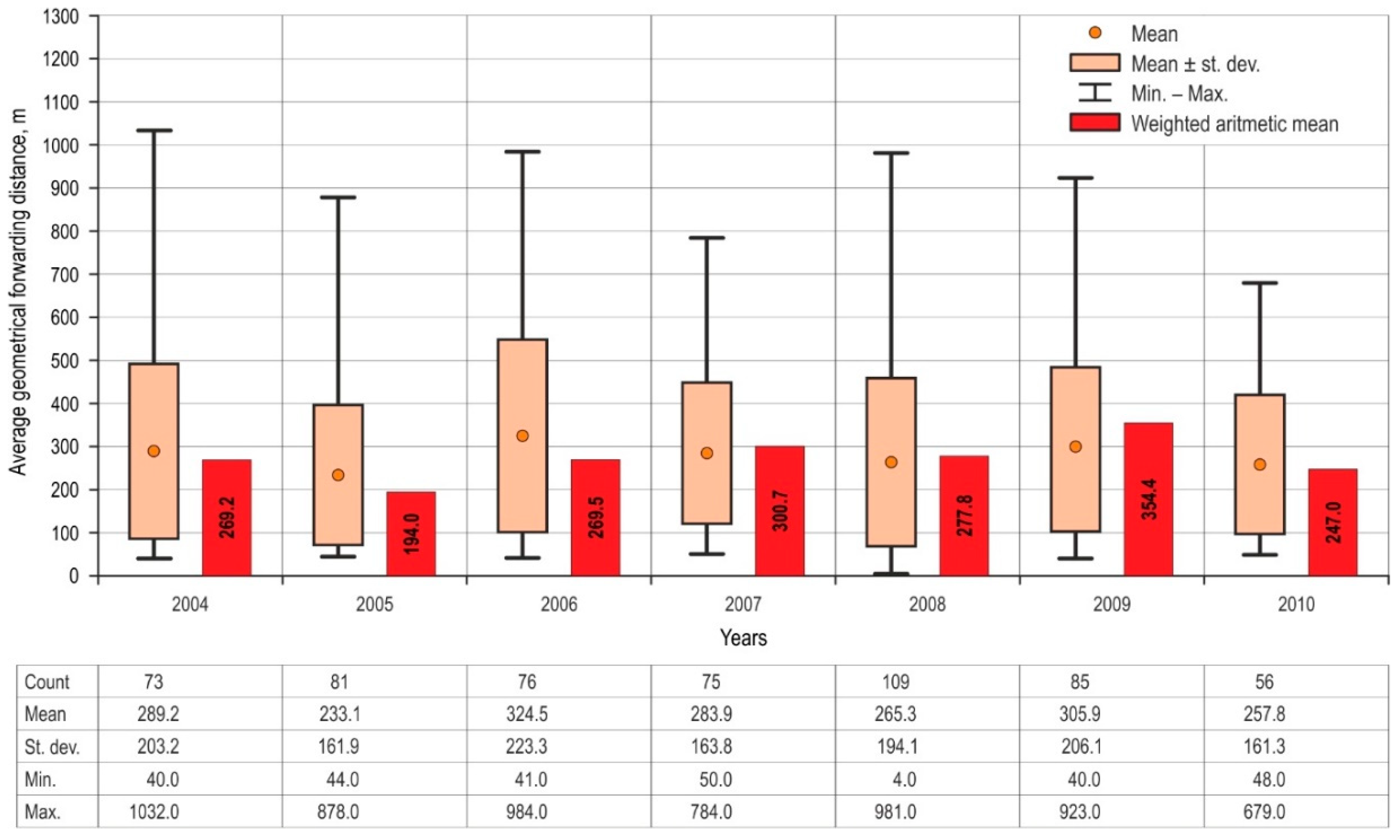
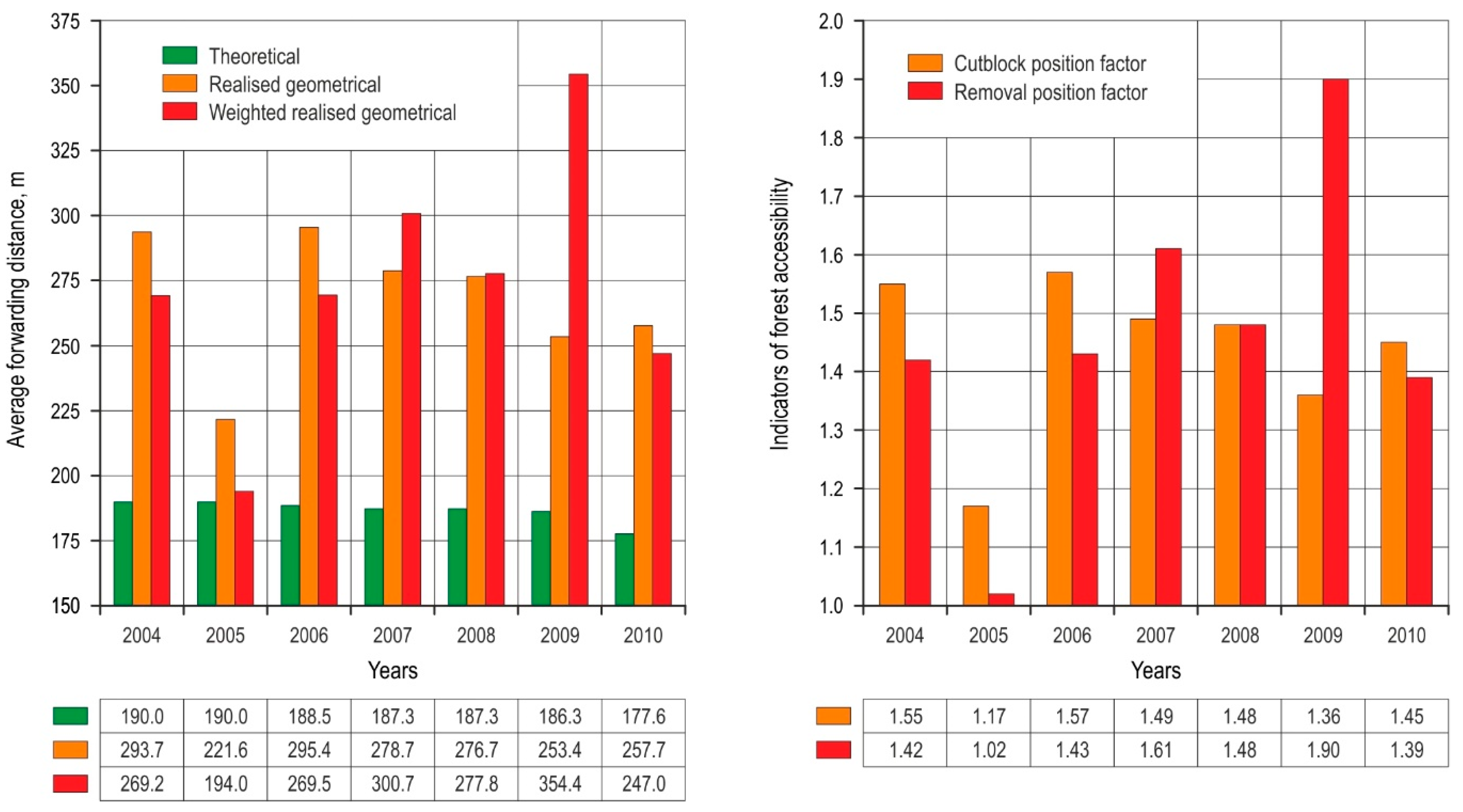
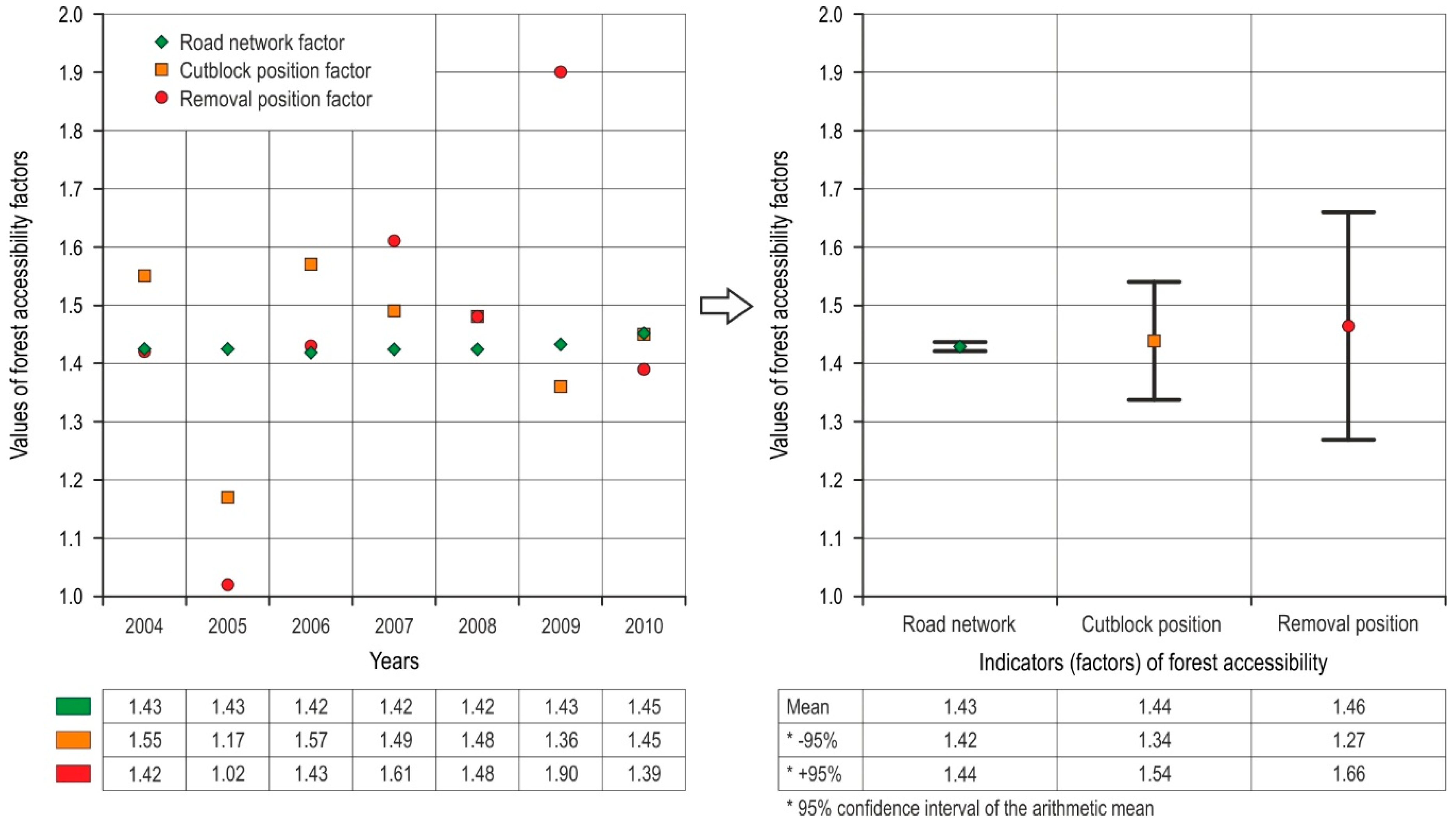
| Sample | Sum | Mean | Variance | |||
|---|---|---|---|---|---|---|
| 2004 | 3 | 4.395263 | 1.465088 | 0.005414 | ||
| 2005 | 3 | 3.615263 | 1.205088 | 0.041983 | ||
| 2006 | 3 | 4.418568 | 1.472856 | 0.00711 | ||
| 2007 | 3 | 4.524453 | 1.508151 | 0.008854 | ||
| 2008 | 3 | 4.384453 | 1.461484 | 0.001028 | ||
| 2009 | 3 | 4.692636 | 1.564212 | 0.085884 | ||
| 2010 | 3 | 4.291577 | 1.430526 | 0.001232 | ||
| Road network factor | 7 | 10.00221 | 1.428887 | 0.000117 | ||
| Cutblock position factor | 7 | 10.07 | 1.438571 | 0.018748 | ||
| Removal position factor | 7 | 10.25 | 1.464286 | 0.069562 | ||
| ANOVA | ||||||
| Source | Sum of Squares | Degree of Freedom | Mean Square | F | P | F crit |
| Line | 0.23223 | 6 | 0.038705 | 1.556872 | 0.241774 | 2.99612 |
| Column | 0.004685 | 2 | 0.002343 | 0.094234 | 0.910737 | 3.885294 |
| Error | 0.298328 | 12 | 0.024861 | |||
| Total | 0.535244 | 20 |
| Opened Area | Unopened Forest Area (ha) | Total Forest Area (ha) | Relative Openness (%) | ||
|---|---|---|---|---|---|
| Year | Inside MU | ||||
| Single Opened | Multiple Opened | ||||
| 2004 | 1828.01 | 1744.30 | 666.17 | 4238.48 | 84.28 |
| 2006 | 1859.21 | 1745.56 | 633.71 | 4238.48 | 85.05 |
| 2008 | 1849.24 | 1755.53 | 633.71 | 4238.48 | 85.05 |
| 2009 | 1837.21 | 1745.42 | 632.18 | 4214.81 | 85.00 |
| 2010 | 1814.66 | 1811.58 | 584.07 | 4210.31 | 86.13 |
Publisher’s Note: MDPI stays neutral with regard to jurisdictional claims in published maps and institutional affiliations. |
© 2020 by the authors. Licensee MDPI, Basel, Switzerland. This article is an open access article distributed under the terms and conditions of the Creative Commons Attribution (CC BY) license (http://creativecommons.org/licenses/by/4.0/).
Share and Cite
Đuka, A.; Bumber, Z.; Poršinsky, T.; Papa, I.; Pentek, T. The Influence of Increased Salvage Felling on Forwarding Distance and the Removal—A Case Study from Croatia. Forests 2021, 12, 7. https://doi.org/10.3390/f12010007
Đuka A, Bumber Z, Poršinsky T, Papa I, Pentek T. The Influence of Increased Salvage Felling on Forwarding Distance and the Removal—A Case Study from Croatia. Forests. 2021; 12(1):7. https://doi.org/10.3390/f12010007
Chicago/Turabian StyleĐuka, Andreja, Zoran Bumber, Tomislav Poršinsky, Ivica Papa, and Tibor Pentek. 2021. "The Influence of Increased Salvage Felling on Forwarding Distance and the Removal—A Case Study from Croatia" Forests 12, no. 1: 7. https://doi.org/10.3390/f12010007
APA StyleĐuka, A., Bumber, Z., Poršinsky, T., Papa, I., & Pentek, T. (2021). The Influence of Increased Salvage Felling on Forwarding Distance and the Removal—A Case Study from Croatia. Forests, 12(1), 7. https://doi.org/10.3390/f12010007






